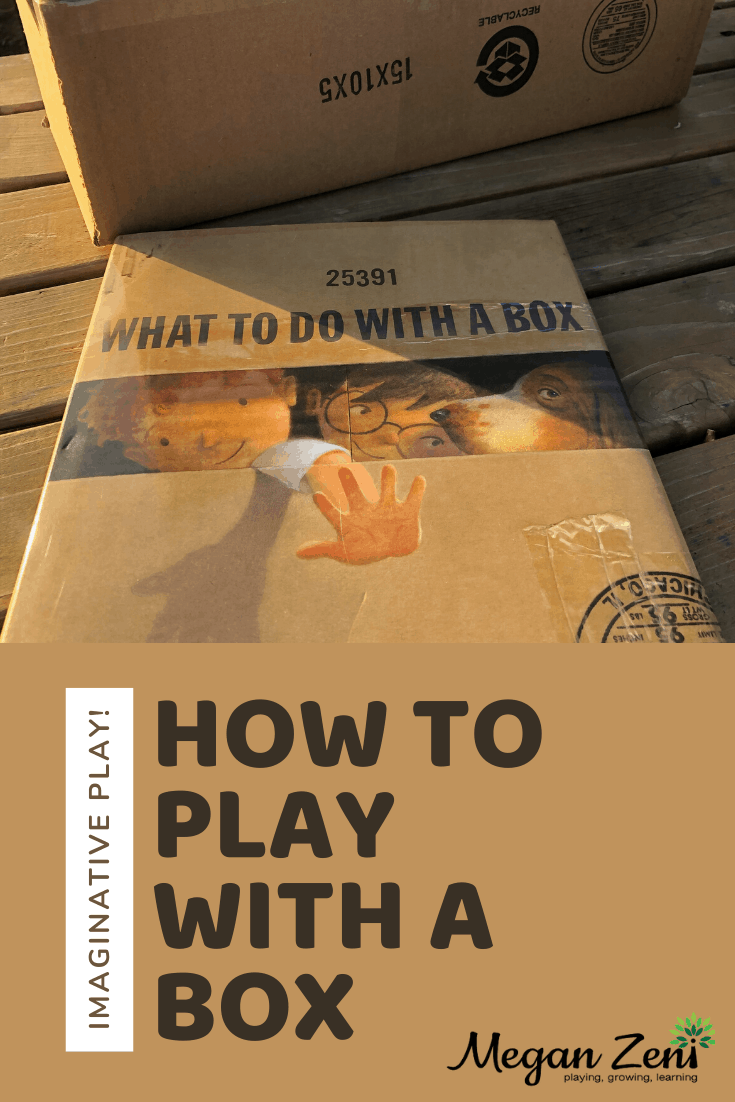- filed under: Book Recommendations, Imaginative Play Outdoors, Literacy Outdoors
Imaginative play with a box
This post has been written to support imaginative play with a box at home. If you have boxes available from deliveries, or are expecting deliveries, save your boxes for potentially hours of imaginative play at home!
Imaginative play is essential for children to make sense of the world around them, and when play is supported by thoughtful adults it can contribute greatly to cross-curricular academic learning. That said, imaginative play allowed simply for the pleasures and joy it brings to childhood is enough.
Play should not have to be justified by the mountain of evidence that supports what generations of play scholars have said all along: Play is how children learn. We know from the research that children will experiment with limits, practice social behaviour, and work through their frustrations and worries experienced in the adult world through imaginative play.
Now is exactly the right time to give your children (and students, for teachers reading this!) lots of unstructured play time to process what the world is collectively going through. For this activity you can listen to the story together, and then find a spot (outdoors if you have access!) to allow your child to independently imagine and play with the ideas and invitations this story provokes.
Play themes related to our current pandemic are likely to emerge. Holding space for children to work through how they are feeling is important. You can read more about letting children play with coronavirus themes here.
Required materials
- a box or multiple boxes
Optional materials
- scissors
- crayons, markers, glue, tape, paint and brushes
- loose bits and crafty pieces to embellish your box (think junk drawer items)
Not A Box
Thank you to Harper Collins Children’s Books who have granted permission for their books to be read aloud online as a spark, and an invitation for imaginative play during this time. If you would like to order this book for your own library, you can purchase it online here: NOT A BOX
Other books that inspire imaginative play with a box
There are strict guidelines in place around which publishers are allowing books to be read aloud online. The following listed books have not released details of if, or when, their books can be read aloud online. If I find, or receive permission, I will add them to this post! In the meantime, you can add them to your wish list of box books that inspire imaginative play.
A Box Story by Kenneth Kit Lamug
What To Do With A Box by Jane Yolen
The Benefits of imaginative play
In the curricular area of language arts, we know that imaginative play improves vocabulary, language comprehension, imagination and understanding of story elements and structure.
When we think about our core competencies for learning, (which in British Columbia includes communication, personal and social responsibility, as well as thinking skills, like creative, critical and reflective thinking) we can add to the list of benefits from imaginative play increased attention spans, enhanced imagination, impulse control, curiosity, problem solving, cooperation, empathy, and group participation.
In my experience, one of the best features of imaginary play is the endless opportunity for children to interpret, problem solve, and role play in a way that reduces the anxiety and frustration of their daily lives. You might be surprised to see how therapeutic imaginative play can be for your children!
A favourite activity in the outdoor classroom, is playfully imagining what a box can be. We are always so impressed to see what creative and wonderful inventions live in our students’ imaginations. Here are some examples of what they have invented, built, and imagined to inspire your own not a box creations!
We’ve seen everything from space ships, to zombie pyramids, to trampolines and race cars! What can you create with your box?
One of my favourite creations was this pop up garden! Check it out:
As a doctoral student in the faculty of education, I am deeply engaged in the theories and research that influence my thinking. Educators or parents who want to read more about the cited benefits of imaginative play are encouraged to read the following research.
Bergen, D. (2002). The role of pretend play in children’s cognitive development. Early Childhood Research & Practice, 4(1)
The Importance of Being Playful by Elena Bodrova & Deborah J. Leong (2003)
Douglas, S. L., Stirling, L., & Taylor & Francis eBooks A-Z. (2016;2015;). Children’s play, pretense, and story: Studies in culture, context, and autism spectrum disorder. New York, NY: Routledge Taylor & Francis Group. doi:10.4324/9781315817835
Pyle, A., DeLuca, C., & Danniels, E. (2017). A scoping review of research on play‐based pedagogies in kindergarten education. Review of Education, 5(3), 311-351. doi:10.1002/rev3.3097
Vygotsky, L.S. (2004). Imagination and creativity in childhood. Journal of Russian & East European Psychology, 42(1), 7-97. doi:10.1080/10610405.2004.11059210
If you are looking for more curated ideas on imaginative play, join me on Pinterest here:

